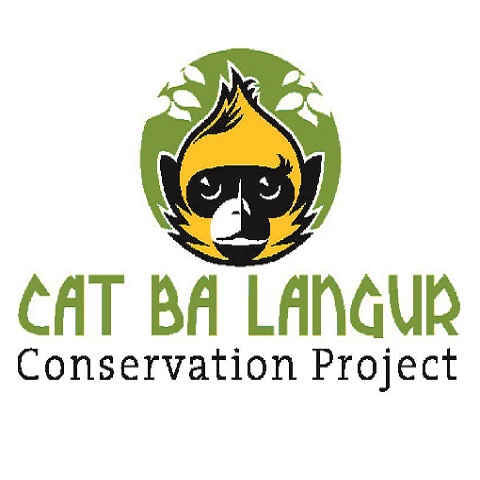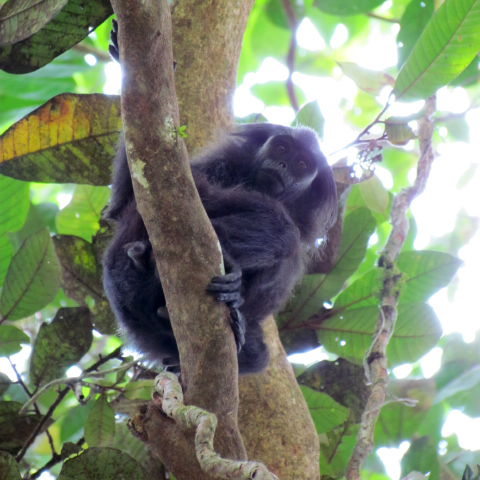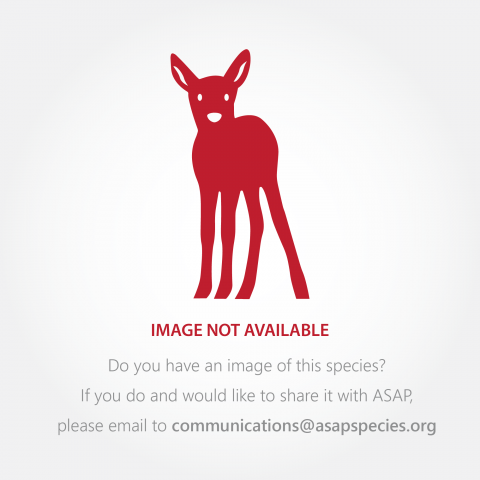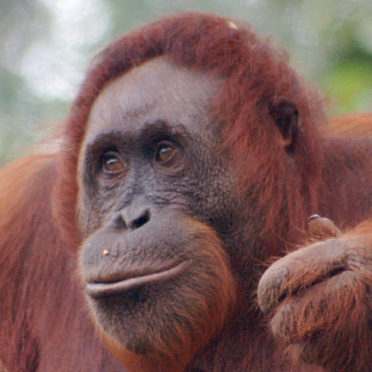Conservation Actions
This species is currently listed in CITES Appendix II. Classified as Critically Endangered and listed as a Top 25 Endangered Primate since 2000.
Since November 2000, T. poliocephalus and its habitat on Cat Ba have been the subject of the Cat Ba Langur Conservation Project (implemented by the Münster Zoo and the Zoological Society for the Conservation of Species and Populations, ZGAP, currently administered by Zoo Leipzig), which has been focused on the improvement of protection status for the species and its habitat, and has initiated two important programs. The first is a langur sanctuary located inside Cat Ba National Park and a "buffer zone" of the World Heritage Site "Halong Bay". Fifty-eight percent of the remaining population lives in the sanctuary. The second is a Langur-guarding program that is meant to protect 42% of the population that exists elsewhere in the national park. This program puts the subpopulations and their ranges under joint control of the national park and local people who patrol the ranges and offer community conservation education. The most important steps in the recovery of this subspecies now are continued protection from encroachment, a reduction in the habitat fragmentation and subpopulation isolation, and an increase in reproductive output and genetic health of the entire population, suggesting the need for translocation and meta-population management, including the ex-situ population. Poaching of the Langurs specifically appears to have completely stopped on Cat Ba with the last confirmed incident in 2001, although the threat remains and the drop in population in early 2016 raises the possibility that poaching by non-local people is experiencing a revival.
A few T. poliocephalus are held in the collection of the Endangered Primate Rescue Center, Cuc Phuong National Park, Viet Nam (Nadler 1999), numbering five individuals at time of writing, coming from only two founders.
Some of the recommended interventions are connecting populations across sites and designing management plans for the small captive population (Lees et al. 2014).
Location Information
This species is known only from northern Viet Nam. Trachypithecus poliocephalus is confined to Cat Ba Island, in Ha Long Bay off the northeastern coast of Viet Nam. There it is further restricted to an area of occupancy of less than a 22 km². The entire population resides within Cat Ba National Park after the 2006 expansion of the park borders to include langur habitat (Decision No. 2355/QD-UBND). The Langurs are regularly seen at sea level and collar data from two translocated individuals indicates a preference for habitat ranging from sea level to 130 m elevation (CBLCP unpublished information).
Geographic Range
Extant
Viet Nam
Population Information
The confirmed population of Trachypithecus poliocephalus in June 2016 was 51-54 individuals (30-35 mature individuals), a sharp drop from was 64-70 as of November 2015 (CBLCP unpublished information). As of this update the reason for this drop appears to have been poaching by people from the neighbouring province (Neahga Leonard in litt., 31 October 2019). Previously published population numbers contain errors and a reevaluation of observation records indicates that in 2000 the population totalled between 40 and 53 animals. Records indicate that in 2003 the count was 40 confirmed animals, reaching 48 by 2010, and 56 by early 2014 (Leonard et al. 2015). Exact counts are difficult as some groups remain in inaccessible areas and are rarely seen.
Previous population counts were not given at a regular time on the year, resulting in the appearance of a much greater fluctuation in population than is actually the case. A January 01 population count from 2001-2019 based on CBLCP records removes some variation in previous population counts: 2000 47; 2001 47; 2002 40; 2003 40; 2004 40; 2005 43; 2006 46; 2007 47; 2008 48; 2009 49; 2010 48; 2011 50; 2012 49; 2013 53; 2014 56; 2015 59; 2016 53; 2017 55; 2018 57; 2019 60 (CBLCP unpublished information). The years prior to 2003 do not have reliable population counts. The total population as of October 2019 is 67 individuals (Neahga Leonard in litt., 31 October 2019).
Population numbers taken at the middle of the year often report higher numbers than the year-end/year-beginning counts due to them being taken after the majority of birth have taken place, but before infant mortality due to infanticide during the latter half of the year (Neahga Leonard in litt., 31 October 2019).
In 2015 there were three isolated subpopulations, down from a reported seven subpopulations in 2004. Movement observations in 2014 and 2015 indicate that at least two of the previously recorded seven subpopulations should be considered as a single subpopulation.
Despite the decline in the number of subpopulations the over-all population numbers are on the rise, with a brief down-turn in 2015. Group size averages 5.9 to 6.5 animals, based on the October 2019 population of 67 individuals in 10-11 groups. Within each subpopulation some groups are single sex and there are several cases of solitary animals, usually male. Average population growth is 2-3% per year with year-by-year variation from -10% to +8% (CBLCP unpublished information).
The population declined to an estimated 500-600 langurs in 1970-1986 from an estimated 2,400-2,700 langurs that appears to have thrived in the ‘optimal’ karst habitat (Nadler and Long 2000). The population declined further in 1999-2000 by 50% or more from 104-135 individuals to 40-53 individuals.
Phan et al. (2014) reported a population of 50-60 individuals on Cat Ba Island, in 12 groups of 4.67 individuals and through simulation studies predict an increase to 86 individuals in 2050. A more recent PVA (Lees et al., 2014) indicates a best guess increase in population to 200-300 individuals by 2050. The October 2019 population of 67 individuals is divided into 10-11 groups, including solitary animals and a bachelor male group, with an average group size of 5.9-6.5 individuals. Attempted male take-overs resulting in group fragmentation and reforming accounts for the variability in group number and size (Neahga Leonard in litt., 31 October 2019).
The 2014 PVA (Lees et al.) calculated extinction risks in two sites across the island and one off the island: The Sanctuary, Cua Dong, and the captive population at the Cuc Phuong National Park. The analyses showed a moderate extinction risk for the first population i.e. the Sanctuary with a 10.6% risk of extinction in the worst case scenario or ‘pessimistic’ case over 100 years. The Cua Dong population was most at risk with a 40.5% risk of extinction at the worst case scenario over 100 years. The low reproductive rate and low carrying capacity of the site increase the probability of extinction. The captive population ran a very high extinction risk of 100% in the worst case and 95% in the best case (or ‘optimistic’) over 50 years, owing to the susceptibility of the population to inbreeding and due to small population size.
Births per year have been steadily increasing, with approximately 30% of the reproductively active females giving birth per year from 2014 until present (2019) except for 2016. A concurrent increase in infant mortality has been recorded, the majority of which have been linked with infanticide during male take-over attempts. This combined with the current lack of predators on Cat Ba indicates that the primary cause of infant deaths is likely to be infanticide (Neahga Leonard in litt., 31 October 2019).
From 2014 to October 2019 infant mortality has averaged 22%, but is highly variable on a year-by-year level, ranging from 13% to 36%. Infant mortality averaged over the years the CBLCP has been active, 2000-present (2019) is 16% with a variation ranging from 0% to 36% on individual years (Neahga Leonard in litt., 31 October 2019).
Threats
Poaching, primarily for traditional "medicine" with secondary hunting for sport has been recognized as the most severe historical threat to Cat Ba Langurs, and the reason for the precipitous decline in their population over the past decades (Nadler and Long, 2000). Reproductively valuable males were often the most common victims due to their behavior (Stenke and Chu Xuan Canh, 2004). This is highly questionable, however, as their behaviour is not enormously different and, if anything, females would be easier to hunt as they are often grouped together and there are more of them per group (Leonard Neahga in litt., 31 October 2019).
Hunting for meat seems to have happened rarely due to the reputed poor taste of langur meat.
Habitat disturbance and fragmentation resulting from the growing human population on Cat Ba Island (due in large part to the country's designation of the island as a new tourism center for northern Viet Nam), and rampant fires due to honey collectors (Nadler and Long, 2000) are also threats.
Poorly regulated tourism in the inadequately managed Cat Ba National Park has direct effects on langur natural history, such as the disturbance to habitat in the karst archipelago where these monkeys live. The small size and fragmented nature of the remaining Cat Ba Langur population means that the species is at risk of inbreeding effects (or intrinsic effects to avoid inbreeding by not breeding at all), extremely limited mate-choice due to the small number of available females, and the chance of a natural or human disaster causing total or effective extinction. However, according to Leonard Neahga (in litt., 31 October 2019) the population would have been very small even at its peak, and would have been small for the last 12,000 years when the langurs were confined to Cat Ba as a result of rising sea levels. It is unlikely that the population was ever above 4-5,000 individuals at any point over the last 12,000 years. This suggests that major inbreeding effects would have already happened in the deep past and, potentially, been weeded out. The threat of disease remains a major concern.
The presence of a group of non-native macaques on a nearby tourist island that have extensive daily contact with humans is a cause for concern due to the potential of escape and disease transmission.
Partners
IUCN Red List Account Link
Please click here to see the species' IUCN Red List Account page.Photo Credits
Neahga Leonard (category and featured image)








